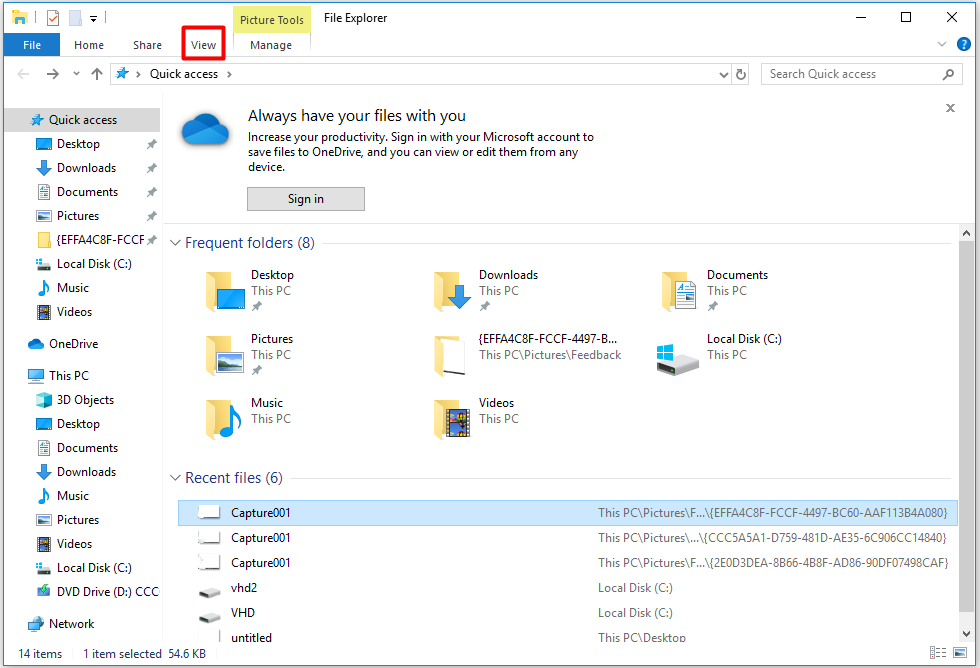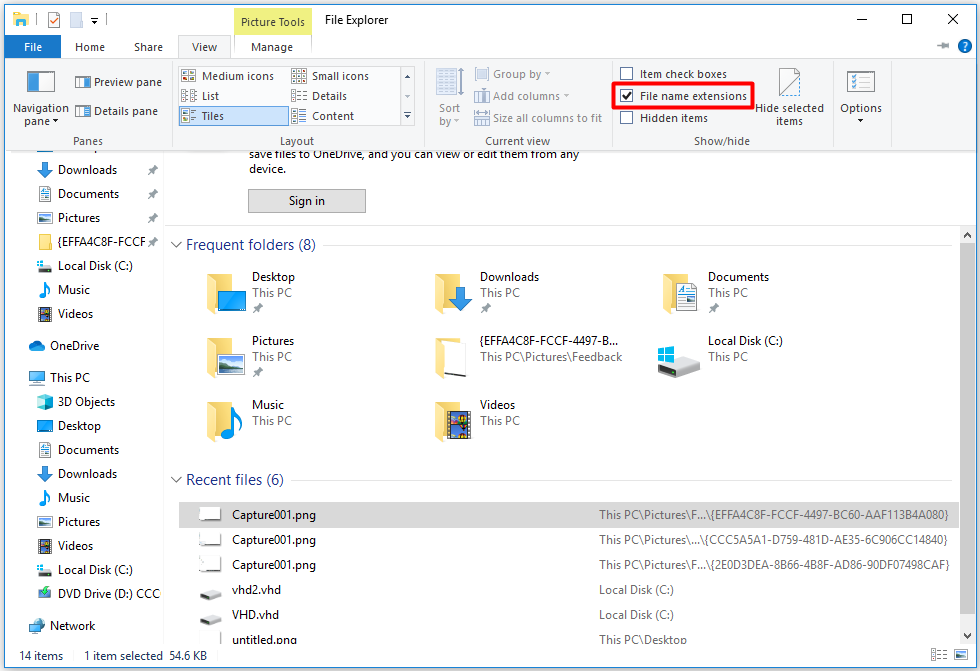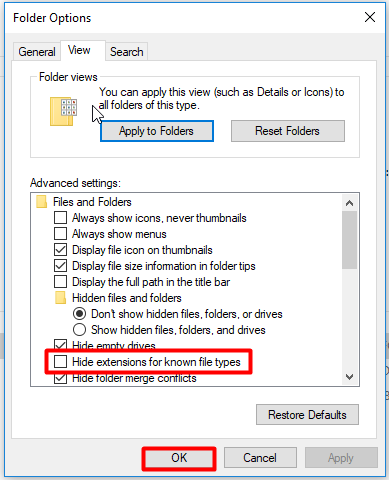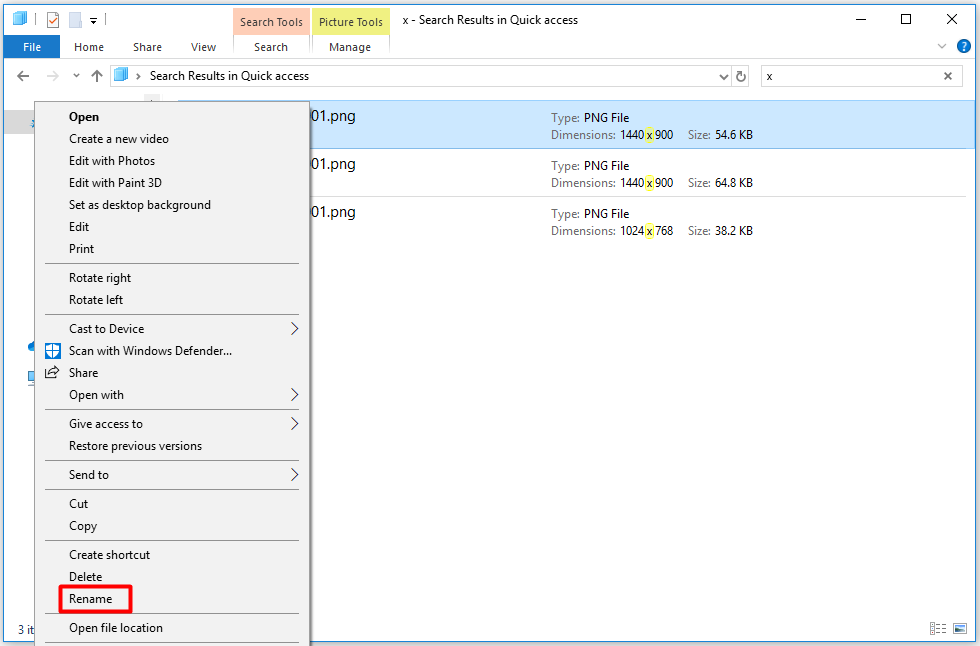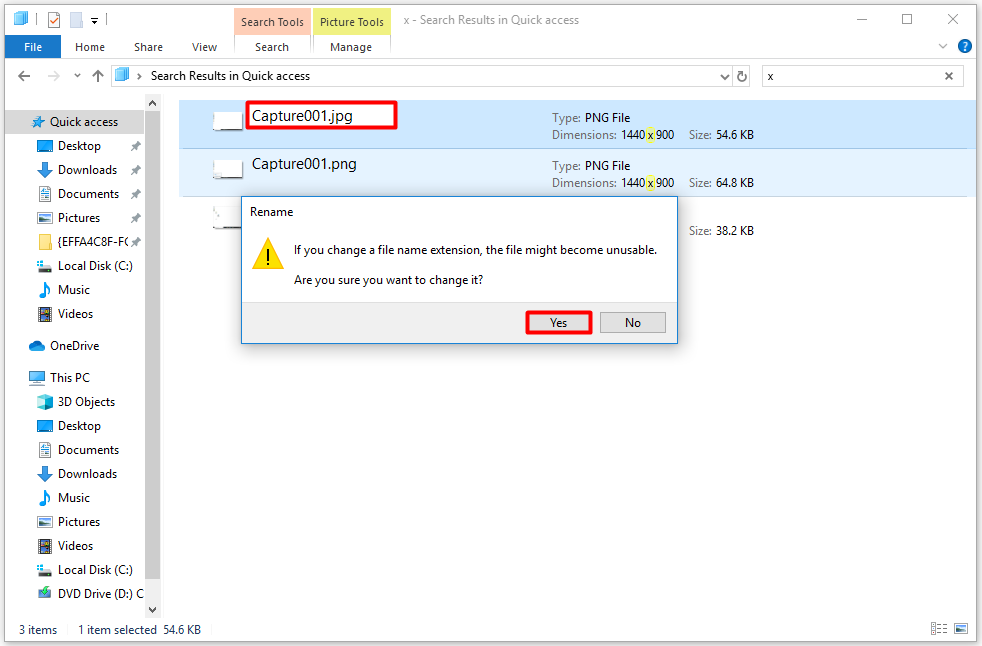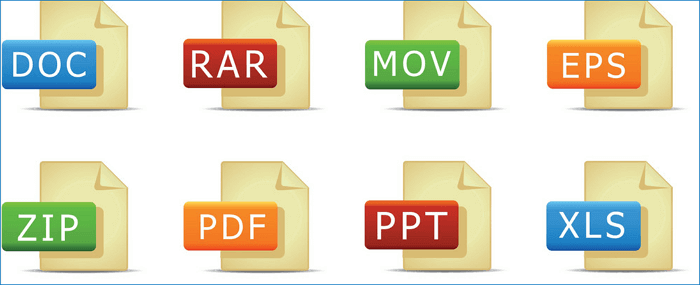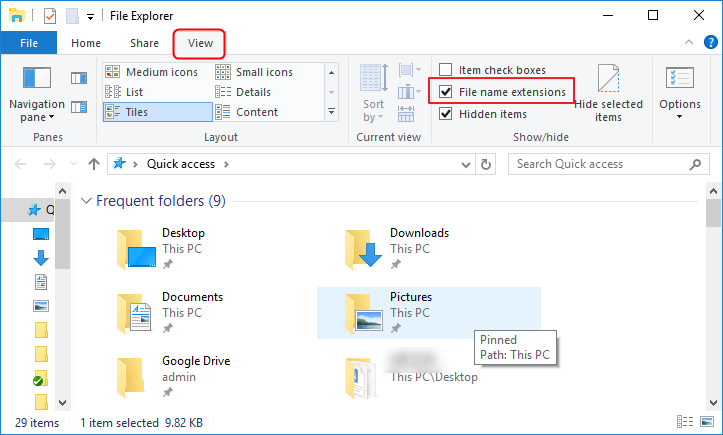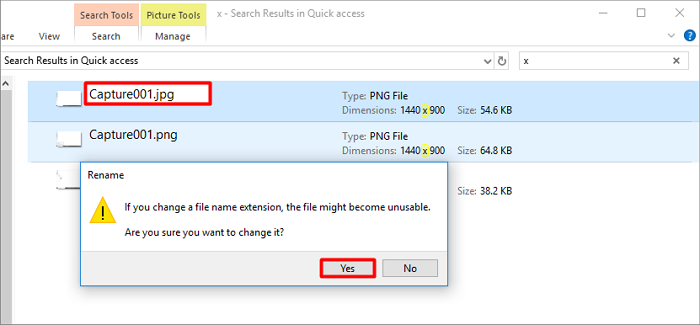-
Partition Wizard
-
Partition Manager
- How to Change File Extensions in Windows 10 Correctly
By Amy | Follow |
Last Updated December 02, 2022
When you transfer pictures or documents, you notice that there is a letter code at the end of files. In fact, the code is a file extension tell Windows what kind of file type the file belongs to. While in this post, MiniTool will tell you how to change file extension Windows 10.
What Is File Extension
A file extension or known as filename extension is a suffix at the end of a computer file. In Windows PCs, file extensions are used by operating systems to recognize what applications are related to what file types.
The file extension is a three-letter code appearing at the end of the file name. If you have opened documents or checked pictures, you may notice these letters. For example, if a file is named as awesome.doc, .doc is the file extension, which indicates that this file is created with Microsoft Word.
There are many kinds of file extensions, so only a small part of frequently used file extensions will be listed here.
- DOC/DOCX: A Microsoft Word document. DOC is the original extension that is used for Word documents, but Microsoft changed the format when Word 2007 debuted. Now, Word documents are based on the XML format, and thus “X” is added at the end of the extension.
- XLS/XLSX: – A Microsoft Excel spreadsheet.
- PNG:Portable Network Graphics — a lossless image file format.
- HTM/HTML:The HyperText Markup Language format is used for creating web pages online.
- PDF:The Portable Document Format, developed by Adobe, is used to maintain the format in distributed documents.
- EXE:An executable file format used for programs you can run.
To change file extension Windows 10, you need to know how to show file extensions in Windows 10. All the file extensions are hidden by default. However, sometimes you may need to check your file extensions for certain purposes. The following is the method to change file extension in Windows 10.
How to Change File Extension in Windows 10
If you want to change file extension after seeing the full file name, you should be cautious about it. Do not change file extensions unless you have enough reasons, because changing file extensions may lead to trouble.
If a file extension in Windows is deleted, Windows won’t know how to deal with the file.
When you change a file extension, for instance, after renaming the file “coolpic.jpg” as “coolpic.txt”, Windows will try to open the file with the application that is related to the new file extension. However, you will just receive an error message or open a useless document.
How to change file extension in Windows 10? To change file extensions correctly, follow the steps given in below.
Step 1: After opening File Explorer, click the View option to view ribbon menu.
Step 2: Then check the File name extensions option to enable file extensions to be displayed in Windows 10.
Alternatively, you can also click Options on the uppper right corner to disable the Hide extensions for known file types option from File Explorer Options in Windows 10 by unchecking the option.
Step 3: Find the file that you would like to change through the search window. When you find the file, right click it. Select the rename option from the menu, and then type the new file extension.
Step 4: Then there will pop up a warning window on the page. If you confirm to change it, click Yes to finish the operation.
This is all the steps to change file extensions on Windows 10. If you change file extensions on Windows 7/8, you can read this post by clicking here.
Bonus Tip
If you are looking for a Windows partition manager, MiniTool Partition Wizard is a good option. It works on Windows 11/10/8.1/8/7 systems. With this software, you can rebuild MBR, migrate OS to SSD/HDD, convert MBR to GPT (vice versa), wipe disk, recover data, etc.
About The Author
Position: Columnist
Having writing articles about computer tech for a long time, I am rather experienced especially on the aspect of computer optimization, PC enhancement, as well as tech terms explanation. The habit of looking through tech forums makes me a great computer issues collector. And then, many articles related to these issues are released, which benefit plenty of users. Professional, effective, and innovative are always the pursuit of an editing worker.
Do you want to change a file extension of a file in your Windows 10 system? File extension describes the type of file. Like ‘. dox’ is a document file, ‘.xlsx’ is an excel sheet. The file extension is always added as a suffix to the file name.
The changed file extension must be compatible with your existing file like a file with an image may have an extension .png and you might change it to .jpeg, both are an extension of the file containing the image.
In this section, we will discuss the method to change a file extension in Windows 10.
Step 1: In Windows 10 by default the file extension is hidden. As you can see in the image below the Image file’s extension is hidden. First, we need to unhide the file extension so that we are aware of the file extension of a file.
Step 2: Search for the control panel in the Windows search box.
Step 3: In the control panel window click on the Appearance and Personalization.
Step 4: In the Appearance and Personalization window you have to click on File Explorer Option.
Step 5: A new window File Explorer Options will pop up. Under Advanced settings, you have to uncheck ‘Hide extension for known file type’. After this click on Apply and then on OK.
Step 6: Now, you can observe that the Image file has a .bmp extension.
Right-click on the file and from the displayed options click on Rename.
Step 7: Now you can change the files extension. Like I have changed it from .bmp to .jpeg.
Step 8: A Rename dialog box will pop up which warns you that changing the file name extension might make your file unusable. But if you want to change the file extension then you have to click yes.
Done your file extension is changed.
So, with this method, you can change the file extension in Windows 10. You can explore some more methods to do so. Hope the information is useful. Keep reading.
Change File Extension One-by-One and in Bulk
All the files on your computer need proper applications to open. Sometimes, the installed application on your computer can only open specific files. For example, the app can only open PNG images, but your images are JPGs. Or your computer only works for PPT files, but your file is a PPTX. That’s when you need to change the file extension to the corresponding one. In this article, we will tell you what is file extension, and how to change the file extension in Windows 10.
Main Content:
What is File Extension
How to Change File Extension in Windows 10
How to Change File Extension in Bulk
Bonus Tip: How to Check File System in Windows 10
What Is File Extension
The file extension is also called a filename extension, it is a suffix at the end of your computer files. A complete file name includes the file name and file extension, and the file extension and file name are separated by a dot. The operating system uses file extensions to identify which applications are associated with which file types, in other words, which application will open when you double-click the file.
There are, like hundreds of existing file extensions. Below we have listed some common file extensions.
- DOC/DOCX: Represents for Microsoft Word documents. DOC is the original extension used for Word files. After Word 2007 has released, Microsoft changed the file extension to DOCX. That’s because Word documents are now based on the XML format, so Microsoft added an «X» at the end of DOC.
- XLS/XLSX: Represents Microsoft Excel spreadsheet. The reason why XLSX has an additional «X» is the same as that of a Word document.
- PNG: It stands for Portable Network Graphics, is a lossless image file format.
- HTM/HTML: Represents HyperText Markup Language. It is the format for creating web pages online.
- PDF: It stands for Portable Document Format. It is a file type originated by Adobe and used to maintain formatting in distributed documents.
- EXE: An executable format used for programs you can run.
Now, you can apply the following steps to change the file extension by yourself.
Step 1. Open Windows File Explorer.
Step 2. Click the «View» tab. Tick the «File name extensions» option.
Step 3. Now you can see the file extension of all your files. Find the file that you would like to change the file extension, right-click the file, choose rename, and enter the new file extension.
How to Change File Extension in Bulk
The first method enables users to change file extensions one by one, what if you want to change several file extensions at one time? We are also curious about this question. Is there any method that can finish this task all at once?
Unfortunately, NO.
One method claims that you can select all the files first, and right-click then choose «Rename» to bulk change the file extension. We’ve tried this method. Sadly, you can’t use this method to bulk change file extensions. Even though you have select all the files, Windows will send you a confirmation message every time you changed one file extension.
So even though pages are saying that you can change the file extension in bulk, the methods they offer are actually invalid.
Bonus Tip: How to Check File System in Windows 10
After knowing how to change the file extension, we want to introduce a handy tool that can help you check and fix system errors as well as manage partitions.
Checking for disk errors will help prevent unknown hard disk troubles and troubleshoot disk read errors, storage-related errors, and even system boot problems. And if you got a new hard drive, you also need to manage your hard disk.
One such tool is EaseUS Partition Master Free version. With this tool, users could check and fix the file system with simple clicks. And it also supports users to resize, move, merge, and Copy disks or partitions.
If you are interested in this tool, download it from the button below for free, and follow the guide to see how to check and fix the file system.
Step 1. Open EaseUS Partition Master on your computer. Then, locate the disk, right-click the partition you want to check, and choose «Advanced» > «Check File System».
Step 2. In the Check File System window, keep the «Try to fix errors if found» option selected and click «Start».
Step 3. The software will begin checking your partition file system on your disk. When it completes, click «Finish».
The Bottom Line
That’s all about how to change the file extension in Windows 10. Hope you can fix your problem after reading this article. Don’t hesitate to try the FREE EaseUS Partition Master.
Do you have trouble change file extensions on Windows computer? In an earlier post, we discussed how to convert Samsung voice recording files from 3GA to MP3 format, a couple of readers wrote to us saying “how can you rename a file (the extension) because I can’t see file extensions, I can only rename the ‘normal’ name.” It is true with most Android phones, you can only rename file on mobile but can’t edit file extensions unless you have installed the file explorer, see how to change file extensions on Samsung and Android phones. Today, we will be using Windows 10 in the demo to show you how to display file extensions and change file extension in Windows 10. File extensions of known file types are hidden on Windows 10 PC by default. Only those file types that are not associated with some software installed in your computer display file extensions after file names. This seems to be easier to use for average users. However this could be confusing as well. Many Windows 10 users are confused as file extensions can be found in some files not another. In this guide, we will show you quick ways to turn off “Hide extensions for known file types” feature of File Explorer in Windows 10 so you will not see some files have extensions, other files do not and this allows you to change file extensions in Windows 10.
In order to edit file extensions in Windows 10, you need to change the File Explorer settings to display file extensions first. Open File Explorer in Windows 10 or any folder on your computer hard drive, then switch to the View tab in upper menu to view ribbon menu. Click to check the box before File name extensions option to enable file extension display in Windows 10. Now you can see those hidden file extensions in Windows explorer, including those common file types and file extensions like .exe, .doc, .docx, .xlsx, .jpg, .png, .mp3, mp4, .wmv, etc.
To show file extensions in Windows 10, you can also click the Options button as shown in the upper right corner, then disable the “Hide extensions for known file types” in windows 10 from File Explorer Options as shown below.
Now you can go to change a file name extension within Windows File Explorer. Simply double click a file name then edit file extensions as you like on Windows 10 PC. Alternatively you can right click on the file you like to edit, then choose Rename from the context menu on right click to start changing file extension for the selected file in Windows 10.
Batch change file extensions in Windows 10
Have you ever wanted to change a group of files file extensions in Windows 10? For example, you want to change 100 audio files with .amr extension to .mp3. You do not have to change file extensions one by one. You can make use of the Windows Command Prompt to batch change file extensions on Windows 10 PC.
Firstly create a new folder on your computer. For example, we can create a folder named ‘test’ on hard drive D. Put all those .amr files to this new folder. Then open the Command Prompt in Windows 10. You can right click on the Windows logo at the bottom-left corner of the screen, then choose Command Prompt to open Command Prompt in Windows 10 or simply type CMD in the search box at the bottom-left corner to find and open Command Prompt in Windows 10.
Secondly we need to change path to the created folder in Command Prompt. By default it opens the user folder. Type “d:” without the quotes and press Enter to change to another disk. Type “cd test” and hit Enter to change the current working directory to the “test” folder where all the files you want to change file extensions are saved.
Finally type “ren *.* *.xxx” and hit Enter to change all files’ extension to .xxx. For example, if you want to change them to mp3 files, use the command “ren *.* *.mp3”.
Windows 10 has been released for some time. We have found many new features in this latest Windows OS such as the Edge browser, new Start menu, etc. We also noticed some features have been removed, such as the DVD playback support, now you need to manually download a free DVD Player for Windows 10.
Update May 2018: this article was originally published in Sep 2015 and has since been updated. in this update, we added the new method to batch change file extensions for multiple files in Windows 10.
When we refer to files like MP3s, ZIPs, or PDFs, we’re referring to the file type (or file extension) that allows the operating system to identify what type of file it is and what software is needed to open it. This is how Windows or macOS can determine that an MP3 file needs to be opened by your music player, or a PDF by a PDF reader.
If the file has the wrong file type, then Windows will use the wrong program to open it. This will probably cause an error and stop you from accessing your file—after all, Microsoft Word can’t handle MP3s. If you need to figure out how to change file types in Windows 10 the right way, then you’ll need to follow these steps.
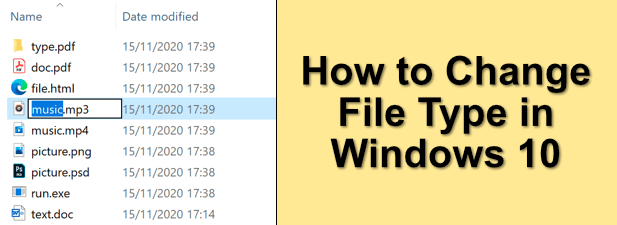
A file extension acts as a way for Windows to determine what to do with a file. It tells the Windows operating system that, when you open an MP4 file, it should open VLC (if it’s installed on your PC). Or when you open a DOCX file, it should open Microsoft Word. For every file type the operating system knows, it’ll match the file extension to software that should be able to open it.
It’s possible to change the file type for files in Windows 10, but this depends on the file itself. Changing file types isn’t just about changing the extension at the end of a file name. If a file isn’t created the “right way” then simply changing the extension won’t work.

Changing the extension doesn’t change what the file ultimately is. An MP3 isn’t a Word document, so changing the file type from MP3 to DOCX won’t suddenly make Word a music player. However, if the file types are similar (for instance, JPG and PNG), then the software may still be able to open the file.
The best way to change file extensions is to save or convert it into an alternative format or use conversion services online. If you’re confident that the file will still open, however, you can quickly rename the extension using Windows File Explorer instead, but this may not work properly.
Displaying File Extensions in Windows File Explorer
Previous versions of Windows showed the file extension for files in Windows File Explorer. In Windows 10, these extensions are hidden by default, preventing you from quickly changing the file type.
If you want to change file extensions using Windows File Explorer, you’ll need to change the setting to view hidden file extensions.
- To do this, open Windows File Explorer. From the ribbon bar, select View > Options > Change folder and search options.
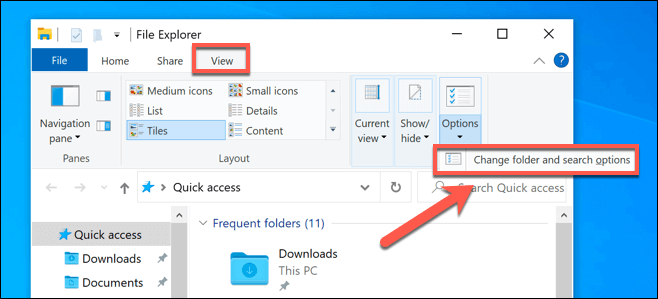
- In the View tab of the Folder Options window, make sure that the Hide extensions for known file types checkbox is disabled, then select the OK button to save.
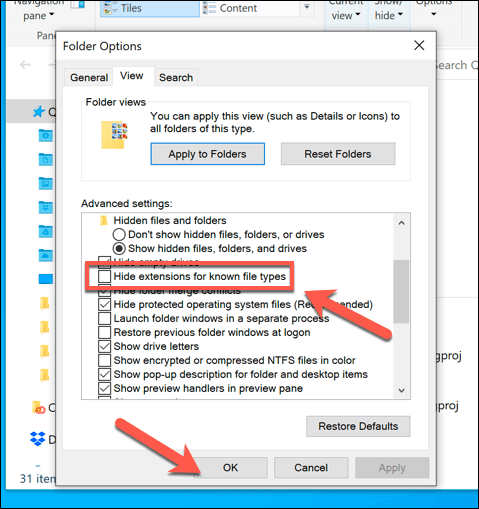
- With this setting disabled, you should now be able to view file extensions as part of each file name in Windows File Explorer.
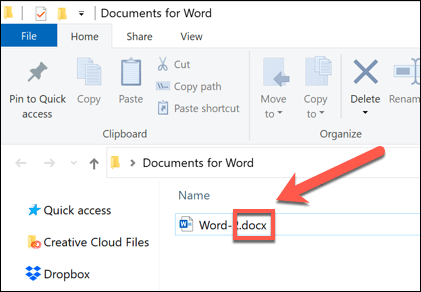
Renaming a File Extension Using Windows File Explorer
With file extensions visible, you can start changing file types by renaming the file and replacing the old extension with the new extension. For instance, replacing file.txt with file.doc would turn a TXT text file to a Word document in the older DOC format. As the file contains text, Word should be able to understand and open it.
However, this only works because software like Word is often smart enough to recognize the contents of certain files, filling in the gaps where it can to open the file. Where changing TXT to DOC would work, this wouldn’t work with the newer DOCX format for Word document, as this newer file type is much more complex.
- If you still want to rename a file type this way, open Windows File Explorer, right-click and file and select the Rename option.
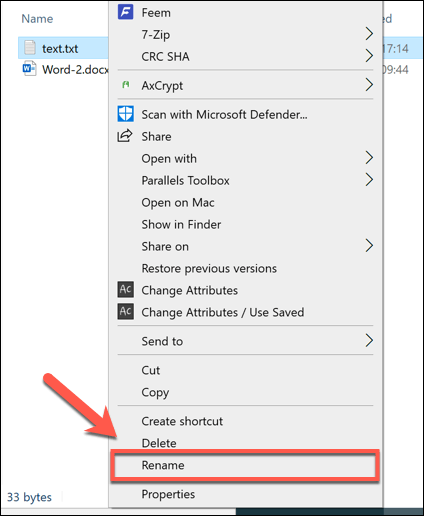
- Replace the older file extension with the new file extension, then press the Enter key or click in the empty white space to save the changes.
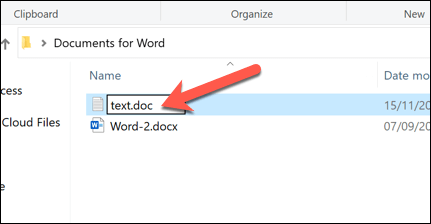
- Windows will warn you that changing file extensions in this way can break the file. If you’re sure you wish to continue, select OK to confirm.
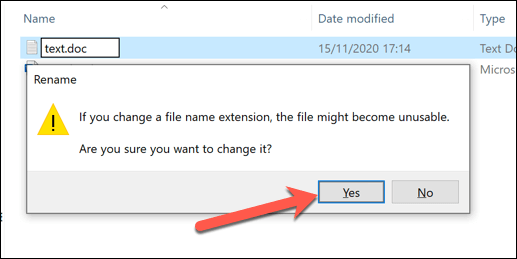
Once confirmed, the file extension will be changed and the file will be listed as the new file type in the Type column. Depending on the file extensions used, you should now be able to open the file. If the process hasn’t worked, rename the file and return it back to the previous extension.
Saving a File in Another File Format
Renaming a file type in Windows File Explorer doesn’t change the file’s data and can only work in certain (limited) circumstances. If you want to change a file extension properly, you’ll need to save or export it to another format.
This works well with file types that are related. It’s easy enough to change a DOCX file to a PDF, or a BIN to ISO, but it’s more complex to change between very different types. For instance, while a PDF can be exported as images, you can’t simply rename a PDF file to the PNG format.
If the software you’re using is designed to allow editing, you can often save or export a file to another format by selecting File > Save or Save As from the software menu. In the Save As window, you should be able to change the file type of the saved file below the file name.

You’ll need to check what file extensions are supported by the software you’re using. If you want to export your file to a format it doesn’t support, then you’ll need to look for alternative software or consider converting it online using a file conversion website.
Changing File Types Using Online Services
If you don’t have the software to convert a file from one file type to another, you can use online services to do so. Once you upload the file, the remote server will convert it, allowing you to download the file in the new format.

You should make sure to only do this with files that you’re happy to share. Uploading important documents to an unknown server is probably not the wisest idea, especially if you’re worried about online privacy. For non-essential files, however, using this method should be perfectly safe to try.
Given the huge number of different file types out there, it isn’t possible to recommend one service or another. If you do want to try a service like this, however, then try a quick Google search.
For instance, searching for convert x to y (replacing x with the original file type and y with the new file type you want to use) should provide you with a list of potential results.
Managing Files in Windows 10
Once you know how to change file types in Windows 10, you can deal with software conflicts as they occur. You can also safely convert files from one type to another, from music file conversions on your PC to converting PDFs to Google Docs online. If the file is in a similar format, you can even try renaming the file extension itself.
If you’re running out of space for your new files, you may need to look at a disk space analyzer to have a bit of a clean out. There are ways to automatically delete files in Windows 10, but if you’re worried about losing important documents or photos, be sure to look through and backup your files yourself.
Nearly every file in Windows 10 has a file extension. At times, however, there may be a file that you need in a different format. For example, your picture is a .JPG file but you need it as a .PNG. To resolve this, you can rename files in Windows Explorer and have them change automatically.
What is a file extension?
A file extension is a three-letter code at the end of the file name which tells your computer how to interpret it and how it was created. Some you may be familiar with include .exe, .jpg, .docx, and .txt.
When is it safe to change a file extension?
Though you can rename many files to switch their file extension, most will “break” when you do so. This is typically because the file type is specific to a certain code-format.
However, if you turn the file extension of an image (.jpg) into a text file (.txt), you’ll just get random numbers and letters when you open it. Similarly, if you were to turn a .txt file into a .exe, nothing would happen if you tried to run it.
As a result, it’s best to only change a file extension only if you have a good reason for doing so. For example, you accidentally saved it in the wrong format or the file is not working in its current form. However, you can safely experiment by creating a copy of your file and changing its file type instead of the original copy.
Without further ado, here’s how to change file a file extension in Windows 10 by renaming:
How to Change the Extension of a File in File Explorer
Though you can rename files in Windows 10 to change their extension, you first need to change some settings:
- Open File Explorer and press ‘View’ in the ribbon
- Tick ‘File name extensions’
You’ll find the option on the right-hand side of the ribbon.
- Untick ‘Hide extensions for known file types’
Now, still in the “View” tab of File Explorer, click the “Options” button on the far right. In the Folder Options window, click “View”, then scroll down the list until you find an option that reads “Hide extensions for known file types”. Tick it.
- Rename your files in Windows Explorer
You should see that the file now has an extension next to its name, in our case .jpg. Right-click the file or files you want to change the type of in File Explorer and select “Rename”.
- How to change a file extension
Change the extension after your file name to one of your choice – in our case from .png to .jpg. Once you’re done, press Enter. A “Rename” dialog will pop up, warning you that the file might become unusable if you change its file type. If you’re sure you’ve done your research, click “Yes”.
You have successfully changed your file to a different format.
If you found this Windows file extension tutorial useful, you may be interested in our other guides. Here’s how you can open and convert HEIC files and view or edit SVG files. If your file stopped working using this method, you may want to try renaming it back or restoring the file via File History.
Click the View tab in File Explorer and then click the Options button (or click the drop down menu and click Change folder and search options) as shown below. To view file extensions, uncheck the Hide extensions for known file types option. Click OK when done.
Simply double click a file name then edit file extensions as you like on Windows 10 PC. Alternatively you can right click on the file you like to edit, then choose Rename from the context menu on right click to start changing file extension for the selected file in Windows 10.
How do I change the extension of a file?
You can also do it by right-clicking on the unopened file and clicking on the “Rename” option. Simply change the extension to whatever file format you want and your computer will do the conversion work for you.
How do I change a file extension in Windows?
How to change a file extension
- Click the file to select it, then click once more. Windows automatically selects the filename so that anything you type will replace the existing name.
- Click and drag over the extension, type the new extension and press Enter.
How do I change a file extension back to original?
1. Go to Control Panel > Default programs and select Associate a file type or protocol with a program. 2. From the list of file extensions, select the extension that you want to change the default program to open with and then click Change program.
How do I change the file type on my computer?
How to change a File Extension in Windows
- Click OK. …
- Now check the box next to File name extensions. …
- Click the View tab in File Explorer and then click the Options button (or click the drop down menu and click Change folder and search options) as shown below.
- The Folder Options dialog box is displayed. …
- Click OK when done.
11 мар. 2017 г.
How do you change a file to MP4?
Go to the upper-left corner, click the Media button, and then select Convert / Save. Click Add to upload any file you want to convert to MP4 and hit the Convert / Save button below. Choose MP4 as an output format in the next window.
Does changing the file extension change the file?
When you change a file’s extension, you change the way programs on your computer read the file. The problem is, changing the file extension does not change the file type. In other words, when you change a file’s extension, it does not change the way the file is formatted.
How do I remove .txt extension?
txt, we remove its file extension by performing the following steps.
…
Windows users
- Right-click the file (not the shortcut).
- Select Rename in the menu.
- Erase the . txt from myfile. txt and press Enter .
- Click Yes on the warning about the file becoming unusable if you’re sure you want to delete the file name extension.
30 июн. 2020 г.
What is an extension of a file?
A filename extension, file extension or file type is an identifier specified as a suffix to the name of a computer file. The extension indicates a characteristic of the file contents or its intended use.
How do I change multiple file extensions in Windows 10?
Step 1: Show file name extensions if you haven’t done so. Step 2: Click the file for which you want to change the file extension to select it, and then click F2 to make the filename and extension editable. Step 3: Select the extension to highlight it, type another extension, and press Enter to confirm it.
How do you show file extensions in Windows 10?
Windows 10:
- Open File Explorer; if you do not have an icon for this in the task bar; click Start, click Windows System, and then File Explorer.
- Click the View tab in File Explorer.
- Click the box next to File name extensions to see file extensions.
- Click the box next to Hidden items to see hidden files.
How do I bulk rename files?
You can press and hold the Ctrl key and then click each file to rename. Or you can choose the first file, press and hold the Shift key, and then click the last file to select a group. Click the Rename button from the “Home” tab. Type the new file name and press Enter.
How do I change my default app to nothing?
Under Settings, locate “Apps” or “App Settings.” Then choose the “All Apps” tab near the top. Find the app that Android is currently using by default. This is the app you don’t want to use anymore for this activity. On the App’s settings, choose Clear Defaults.
How do I fix a file extension problem?
How to Fix File Extension Problems or Error?
- First, click on Start > My Computer > Tools and click the Folder Options or Organize in Windows 7 & Vista.
- After that click the Folder and Search Options.
- Then click the View tab > and remove the check from the box labeled Hide extensions for known file types > click OK.
How do I reset the default program to open a file?
How to reset defalt programs to open files?
- Open Default Programs by clicking the Start button, and then clicking Default Programs.
- Click Associate a file type or protocol with a program.
- Click the file type or protocol that you want the program to act as the default for.
- Click Change program.
22 янв. 2010 г.
With our increasing use of computers in our daily life, it may get necessary even for a simple user to change the file type of a file from one format to another. Each file format has their own properties. For example a ‘.txt’ file will probably get opened by the text editor while an ‘html’ file will get launched in your default browser.
Even though the contents inside the files might be the same, the file type matters a lot. The process of changing file type is quite simple and straightforward. However, there are some cases whereby changing the file type, the file becomes unusable. Hence it is recommended that you know exactly what you’re doing and also make an additional copy of the file.
Showing file extensions and changing the file format
By default, Windows doesn’t have the file format displayed alongside every file. For example, if a file is a text file, its name wouldn’t display ‘ap puals.txt’. Instead, it will only display ‘appuals’. First, we will enable the file extensions and then through basic rename, we will change the file extension. You can also choose to rename files in bulk if there are a lot of files that you need to change the type for.
- Press Windows + E, click View from the top-most ribbon. Now click Options and select the option Change folder and search options.
- Now uncheck the option Hide extensions for known file types. Now all the files will have their file extensions displayed alongside their names.
- Now navigate to the file for which you want to change the file format. Right-click on it and select Rename.
- Now change the file’s extension to the extension of the type which you want to change into. In this example, we change a ‘text’ file to a ‘python’ file. The extensions for a text file are ‘txt’ and for python ‘py’.
Here is a list of common file extensions used in the world of computing. We have listed them according to their type.
Text files
.DOC Microsoft Word Document .DOCX Microsoft Word Open XML Document .LOG Log File.MSG Outlook Mail Message .ODT OpenDocument Text Document .PAGES Pages Document .RTF Rich Text Format File .TEX LaTeX Source Document .TXT Plain Text File .WPD WordPerfect Document .WPS Microsoft Works Word Processor Document
Audio files
.AIF Audio Interchange File Format .IFF Interchange File Format .M3U Media Playlist File .M4A MPEG-4 Audio File .MID MIDI File .MP3 MP3 Audio File .MPA MPEG-2 Audio File .WAV WAVE Audio File .WMA Windows Media Audio File
Spreadsheet files
.XLR Works Spreadsheet .XLS Excel Spreadsheet .XLSX Microsoft Excel Open XML Spreadsheet
Data files
.CSV Comma Separated Values File .DAT Data File .GED GEDCOM Genealogy Data File .KEY Keynote Presentation .KEYCHAIN Mac OS X Keychain File .PPS PowerPoint Slide Show .PPT PowerPoint Presentation .PPTX PowerPoint Open XML Presentation .SDF Standard Data File .TAR Consolidated Unix File Archive .VCF vCard File .XML XML File
Kevin Arrows
Kevin is a dynamic and self-motivated information technology professional, with a Thorough knowledge of all facets pertaining to network infrastructure design, implementation and administration. Superior record of delivering simultaneous large-scale mission critical projects on time and under budget.
Back to top button

Here Is How to Change a File Type in Windows 10
A specific file type is identified by its extension. For a regular Windows 10 user, it shouldn’t be a problem to determine the type of a file just by looking at its extension. It is important for users to know how to identify a file type from a security viewpoint. Since it is possible to add multiple full stops to a file’s name, malicious software often uses this tactic to deceive users. Therefore, by understanding how to change a file extension in Windows 10, you will also know how to identify it. You should also learn how to set your computer to show extensions.
If your computer is not showing file extensions, then you are at risk of being deceived by malware. For instance, a malicious file with multiple full stops may appear like this: companynotes.docx.exe. Now, if your computer is not set to show file extensions, the file will read as companynotes.docx, thereby tricking you into thinking that it’s a Word document, which may lead you to click on it and infect your computer. As you can see, seeing file types in Windows 10 is essential.
Windows lets users change one file type to another. For example, you can change a text file’s extension from .txt to .html. Changing a file’s extension allows the file to be compatible with another piece of software. For instance, the given example allows the TXT file, which can be accessed using Notepad, to be opened by your browser when its extension is converted to .html. So, if you want to find out how to change a file extension, then continue reading.
How to Change a File Extension in Windows 10?
To change any file extension on Windows 10, you first need to set your system to show file types. You can achieve this by following these simple steps:
- Press the Windows Key + E shortcut. Find the View button on the top ribbon and click on it.
- Select Options and click on Change folder and search options.
- Look for Hide extensions for known file types and uncheck the option. Once you are done, all files will be showing their file extensions.
When done with the process, you can now change a specific file’s extension. Follow these steps to do so:
- Access the file you wish to change the extension for and right-click on it.
- Choose Rename, then enter the file extension you want, replacing the existing one in the process.
If you have a specific app that you want to use when opening your file, you can achieve this by following these steps:
- Access the file of interest and right-click on it.
- From the resulting menu, choose Open with.
- Windows will then suggest a list of apps that can open the file type. Find the one you want and set it as the default app for opening this file type by checking the Always use this app box. If for some reason you don’t find the app on the suggested list, you can click on the Look for an app in the Store button. Alternatively, you can click on More apps to access the expanded list.
- Once you have found the app and selected it, you can click on OK to conclude the process.
Other Windows 10 tips could be found here.
Note that all files that have the same extension as the one you just set the default app for will be opened by that particular app in the future.
| Having Difficulty Sending Large Files or Folders Online? Click here |
|---|
| FileWhopper is one of the best and most affordable means of transferring extremely large files and folders online. The platform is designed with the end user in mind and provides simplified tools to create a flawless experience for the user. Since there are no size limits when using FileWhopper, there is virtually no file or folder you can’t send. There is no need for a monthly subscription plan as you only pay a one-off fee based on the size of the file or folder you wish to send. All information is in plain sight with no hidden figures to surprise you later. To top that, your large files or folders are stored securely online for up to 14 days, a period that can be further extended upon request to up to 90 days. Here is how the software works: ✅Select the large file or folder you wish to share online with your preferred recipient(s). ✅Get a one-off quote based on the size of the large file or folder you want to share. ✅Download the tiny FileWhopper app and use it to upload your large file or folder to FileWhopper’s secure servers. ✅Copy the link to the uploaded data and share it with your intended recipient(s). By default, you can send it to one person. However, you can easily add up to 5 extra downloads if you need more users to be able to access your file or folder. Share the password that FileWhopper used to encrypt your file or folder to ensure safe delivery with your recipient(s) so that they can decrypt the data. |

